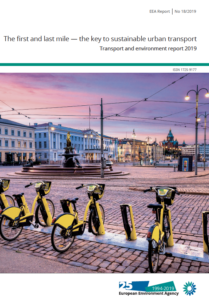First/last/only-mile options in urban freight transport can significantly reduce the environment and health burden of the transport of urban goods. This is very relevant as the effects of traffic noise, air pollution and congestion are most acute in cities. A new EEA report looks at first/last/only-mile options in urban mobility from both passenger and freight perspective.
F/L/O mile options make sustainable urban passenger transport more attractive for the transport user. ‘Good’ F/L/O mile options try to make the whole passenger transport chain as seamless, fast and comfortable as possible. This means avoiding delays, waiting time and transfers, or if they cannot be avoided, making them as comfortable as possible. In contrast, they do not necessarily make sustainable urban freight transport more attractive for the senders and recipients of goods, because sustainable last-mile logistics nearly always incur an extra cost.
The challenge is to see how extra cost might be accepted
The reason for the cost is an extra trans-shipment introduced in a consolidation center at the periphery of the urban area that guarantees maximum environmental efficiency. The large lorry delivers its goods at the consolidation center instead of entering the city to make its deliveries. Smaller, less polluting vehicles then pick up the goods that have been brought in by different lorries and deliver those in a more sustainable way. Therefore, they group the goods of the different lorries and deliver them over shorter routes. In that way, the city distribution trips are optimized and environmental impacts minimized. The extra trans-shipment requires, however, extra time and cost, and often reduces economic efficiency. The lack of economic efficiency is the main reason for the very limited presence of consolidation centers in European urban areas.
Ways to tackle the cost challenge in sustainable urban freight
Creating micro-hubs often reduces the positive environmental impact but increases the economic viability, compared with a large consolidation center. Parcel lockers, proximity delivery points and places where goods are trans-shipped to a more flexible micro-vehicle can all be labeled ‘micro-hubs’. Parcel lockers and proximity delivery points are places where the logistics agent drops the goods and where the final recipient picks up the goods. A typical example of a trans-shipment to a more flexible vehicle is PostNL, a company that brings mail and parcels to micro-hubs in different neighborhoods of Amsterdam. From these hubs, parcels and mail are distributed by cargo bikes. Using the cargo bikes from one large urban consolidation center would be too expensive.
Choose the right niche market
A high concentration of delivery points in combination with many small deliveries made by different carriers represents a niche where urban consolidation has a good chance of succeeding. In this situation, the potential economies of scale provided by a consolidation center will be largest. As a consequence, the chance that a profitable consolidation center can emerge increases. A case study on Gothenburg’s shopping center illustrates this.
Provide added value for clients and make clients pay for it
This added value can consist, for example, of improved return logistics, inventory control, changes in delivery frequencies to meet receivers’ needs, or an attractive fee charged to the senders for transporting the last mile. One of the only ‘successful’ examples of a consolidation center in Europe, ‘Binnenstadservice‘ (Netherlands), succeeded in providing and selling added value to its clients.
Change the regulatory framework by internalizing external costs
By internalizing external costs, urban logistics with F/L/O options become relatively cheap compared with classical delivery. It is difficult to internalize external costs completely. Therefore, other regulatory measures often partially internalize implicit and partially external costs. These measures can take different forms, such as congestion charges, road user charges, time-based access restrictions, and access rules.
The impact of innovative freight F/L/O options remains unclear
Innovations linked to urban logistics include the use of drones and delivery robots that can make journeys from and to the consolidation centers. Today it is unclear how important the role of these F/L/O options could become in the future and what the environmental effects could be. It seems likely that drones and droids will only be able to serve a narrow segment of the urban logistics market (i.e. last-mile delivery to a single or few recipients with low payload). They will also compete for limited urban space. Drones require space to take-off and land, and droids will compete for space on sidewalks with pedestrians. For that reason, some cities, such as San Francisco, already restrict the use of these types of vehicles. In addition, the use of 3D printing could influence urban logistics.
Source: EEA

